全文HTML
--> --> -->通过对大西洋飓风的研究, Molinari 等[11]指出飓风的闪电活动具有三圈分布特征: 眼壁区(0—100 km)存在一定的闪电活动, 但闪电频次较低; 内雨带(100—200 km)闪电活动很少, 但正地闪比例较高; 外雨带(200—300 km)具有较高的闪电频次, 且热带气旋中大部分地闪发生在外雨带. 虽然不同的台风在空间尺度上存在较大的差异, 但闪电的三圈结构被越来越多的研究所证实[12-14]. 在时间演变上, 台风闪电活动一般具有间歇性特征, 即在长时间闪电活动的不活跃期间会伴有短暂的闪电活跃期[15]. 另外一个特征就是台风的眼壁区会出现闪电频数突然增高的现象, 这种眼壁区的闪电爆发通常发生于台风强度快速增强、或处于最强时、或出现眼壁置换阶段[16-20]. 然而, 在东北太平洋和北大西洋也观测到相反的情况, 即眼壁区域的闪电在台风减弱阶段更为显著[15,17,21]. 另外还有一些研究发现眼壁区闪电的爆发与台风的路径也有一定的关系[22,23]. 这些台风内核闪电的演变, 一定程度上揭示了眼壁内的循环机制对起电效率以及电荷结构的影响, 最终通过云内电荷的中和或释放响应云内电荷区位置及强度的改变和调整, 这意味着对台风云内电荷结构的研究对认知闪电活动特征十分重要.
目前, 对台风云内的电场或带电水成物粒子的探空观测较少, 因此耦合了电参数化过程的云模式成为研究台风电活动特征可依赖的手段, 但由于完整地模拟整个台风过程的计算量过大, 使得相关模拟研究仍然十分有限. 要对台风的电活动特征进行模拟, 首先要对云内的起电过程进行参数化. 目前, 所有有关台风的起电参数化方案都是基于对流云的起电机制, 因此有不少工作基于中尺度模式模拟雷暴电过程[24-27], 对热带气旋内部电过程模拟相对较少. Fierro等[19]首次利用云模式对一个理想的飓风微物理过程和电过程进行模拟, 起电参数化方案主要采用感应起电机制[28,29]和非感应起电机制[30], 而闪电放电采用三维随机分叉击穿模型[31], 模拟结果发现在眼壁区电荷结构呈三极性分布, 在眼壁外围的层状云区和很强的外雨带单体中电荷呈偶极性分布. 随后, Fierro和Reisner[32]利用相同的模式对飓风Rita (2005)的闪电活动进行模拟, 主要关注眼壁闪电活动与眼壁对流、飓风强度变化之间的关系. 而有些研究认为热带气旋眼壁区的对流一般具有负的偶极性电荷结构[33,34], 即在云的中部有一个负电荷区, 云的下部有一个正电荷区. 而热带气旋加强阶段眼壁区深对流可以呈现正的三极性电荷结构, 而热带气旋外部螺旋雨带的电荷结构一般是正的偶极性电荷结构[19]. 目前, 关于台风云内电场探空的观测结果未见报道, 而数值模拟利用对流云相关起电机制得到的结果是否合理仍需进一步的观测进行证实和分析, 本文利用2019年1907号台风“韦帕”(文中简称为: 1907号台风)眼壁内的一次电场探空的直接观测资料, 首次分析了台风登陆期间眼壁区内探空路径上的电荷结构特征, 虽然只有一次探空过程获取到了云内的垂直电场信息, 并不能完全代表整个眼壁内的电结构特征, 但可以从观测的角度进一步加深对眼壁闪电爆发机理的理解, 对数值模式起电参数化方案的选取以及模拟结果的验证也具有重要的科学参考.
 图 1 雷达、地闪定位网及电场探空观测站分布 ■: 探空点; Δ: 地闪定位子站;
图 1 雷达、地闪定位网及电场探空观测站分布 ■: 探空点; Δ: 地闪定位子站;  : 雷达站和地闪定位子站
: 雷达站和地闪定位子站Figure1. Radar site and lightning location substation. ■: Electric field sounding site; Δ: Substations of lightning location network;
 : Radar site and lightning location substation.
: Radar site and lightning location substation.电场探空仪依据电晕放电的原理, 采用金属探针作为传感器实现对电晕电流的测量, 然后通过野外地面对比观测得到电场与电晕电流的拟合关系[35], 如(1)式所示, 其中I为电晕电流, 单位为μA, E和E0分别为实时大气电场强度和电晕放电的阈值电场强度, 单位为kV/m. 用金属探针作为传感器, 电场测量值仅是电场总矢量在导线方向的分量. 在实际观测中为了尽可能地反映云内垂直电场, 电晕探针也是垂直放置的. 在这种情况下, 若忽略水平电场的影响, 那么观测得到的电晕电流被认为只是垂直电场的贡献, 由此可利用一维高斯近似公式(2)式计算探空路径上的电荷密度ρ(单位: nC/m3), 其中ε为空气的介电常数(8.86 × 10–12 F/m). 电晕探针的误差较大, 假设电晕探针在垂直方向上的摆动角度为15°, 云内气流速度20 m/s, 在云滴和相对湿度等因素的共同作用下, 电晕电流测量相对误差约为21% [36]. 但探针式电场探空仪优势是设计简单, 成本廉低, 用以整体评估云内电荷区分布及相对强度的比对仍然有效. 在具体分析时, 定义向下的电晕电流为正, 对应的空中电场也定义为正. 探空仪的封装尺寸为30 cm × 20 cm × 12 cm, 重量约1.5 kg. 探针传感器垂直安装于封装外侧, 采集的模拟信号经模数转换后由单片机发送至功率为2 W、工作频段为433 M的数字传输模块, 连同探空仪位置信号一起发送至地面接收站. 地面接收天线为高增益全向天线, 数据传输距离实测达到30 km以上, 接收数据的采样率均为1 Hz.
3.1.1907号台风的基本特征
北京时间2019年7月 30日17:00, 位于南海北部海域的热带云团加强为热带低压, 中心(115.5°E, 18.0°N)位于文昌东偏南约513 km的海面上, 中心附近最大风速15 m/s, 31日08:00加强为2019年第7号热带风暴级台风, 中心附近最大风速18 m/s. 8月1日1:50前后在文昌市的翁田镇沿海登陆, 登陆时中心最大风速23 m/s. 登陆后在文昌滞留9个小时后于8月1日11:00出海, 之后转向偏北方向移动, 图2(b)给出了8月1日9:00文昌登陆后的葵花卫星红外云图. 1日17:40前后在广东省湛江市坡头区沿海再次登陆, 登陆时中心最大风速23 m/s, 登陆后转向偏西方向移动, 穿过雷州半岛进入北部湾海面, 之后沿着广西沿海西行, 2日21:20前后在广西防城港沿海第三次登陆, 登陆时中心最大风速也为23 m/s, 登陆后转向西偏南方向移动进入越南北部, 强度逐渐减弱, 最终于8月3日23:00被中央气象台停止编号. 需要指出的是, 自7月31日8:00加强为今年第1907号台风后直至8月3日8:00, 一直维持热带风暴级别(图2(c)). 另外, 1907号台风中心偏南一侧对流云团长时间在海南岛停滞, 给海南岛带来了较长时间的大风及降水, 海南岛大部分地区的降水在100—400 mm之间.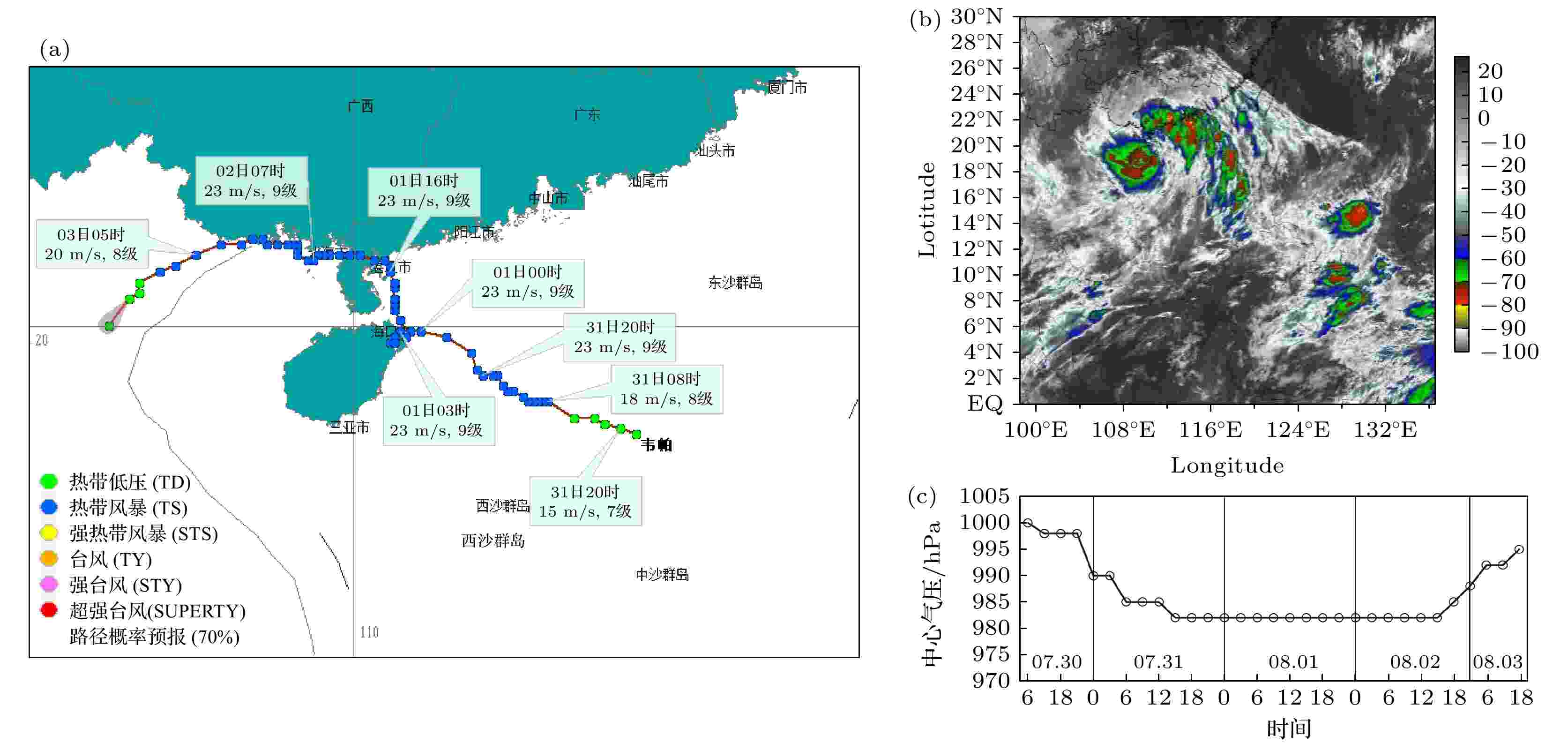 图 2 台风路径及强度变化情况 (a)移动路径; (b)文昌登陆后(8月1日9:00)的葵花卫星红外云图; (c)台风中心气压强度的时间变化
图 2 台风路径及强度变化情况 (a)移动路径; (b)文昌登陆后(8月1日9:00)的葵花卫星红外云图; (c)台风中心气压强度的时间变化Figure2. Typhoon path and intensity change: (a) Path; (b) Himawari satellite infrared cloud image (9:00, 1 August); (c) the evolution of air pressure at the center of typhoon Wipha.
2
3.2.台风前两次登陆期间地闪活动
由于地闪定位网探测范围主要覆盖海南岛和近海区域, 并不能监测远海区域台风的闪电活动情况, 因此, 为了客观地评价台风的地闪活动特征, 这里只对2019年8月1日0:00—20:00时段内的地闪进行了统计, 即1907号台风登陆海南(8月1日1:50)与登陆湛江(8月1日17:40)前后的地闪. 由图3(a)可见, 在此期间该台风登陆前后的地闪活动整体偏弱, 地闪主要以负地闪为主, 负地闪占总地闪数的96.7%. 地闪的整体演变趋势表现为: 台风在登陆海南文昌的过程中(0:00—2:00)地闪的逐小时数目呈显著的增加趋势, 3:00的地闪突然减小至30个/小时, 4:00的地闪数又出现快速增大, 达到了最大的118个/小时, 6:00下降到46个/小时; 在后续发展中, 只在14:00出现了较大的100个/小时, 其余时间都显著小于40个/小时. 虽然台风于7月31日8:00加强为热带风暴级后一直持续到8月3日8:00, 但地闪的演变并未与台风强度表现出一致性, 且地闪活动最频繁时段都出现于两次登陆前后4个小时以内. Zhang等[37]对西北太平洋台风的分析发现, 台风登陆后闪电活动有增强的也有减弱的, 登陆前后闪电的空间分布也不同, 登陆后强台风雨带的地闪密度比台风和强热带风暴的减小得更快, 但热带风暴和热带低压的地闪密度在登陆后增大. 从空间分布图3(b)来看, 正地闪主要发生于琼州海峡至雷州半岛一带以及西部洋面. 图3(c)和图3(d)给出了地闪活动峰值时间04:27和14:32前后15 min内地闪与雷达回波的叠加, 该台风眼附近区域的地闪活动很少, 主要出现于台风的内雨带和外雨带, 由于闪电较少, 宏观上并没有表现出明显的三圈结构特征.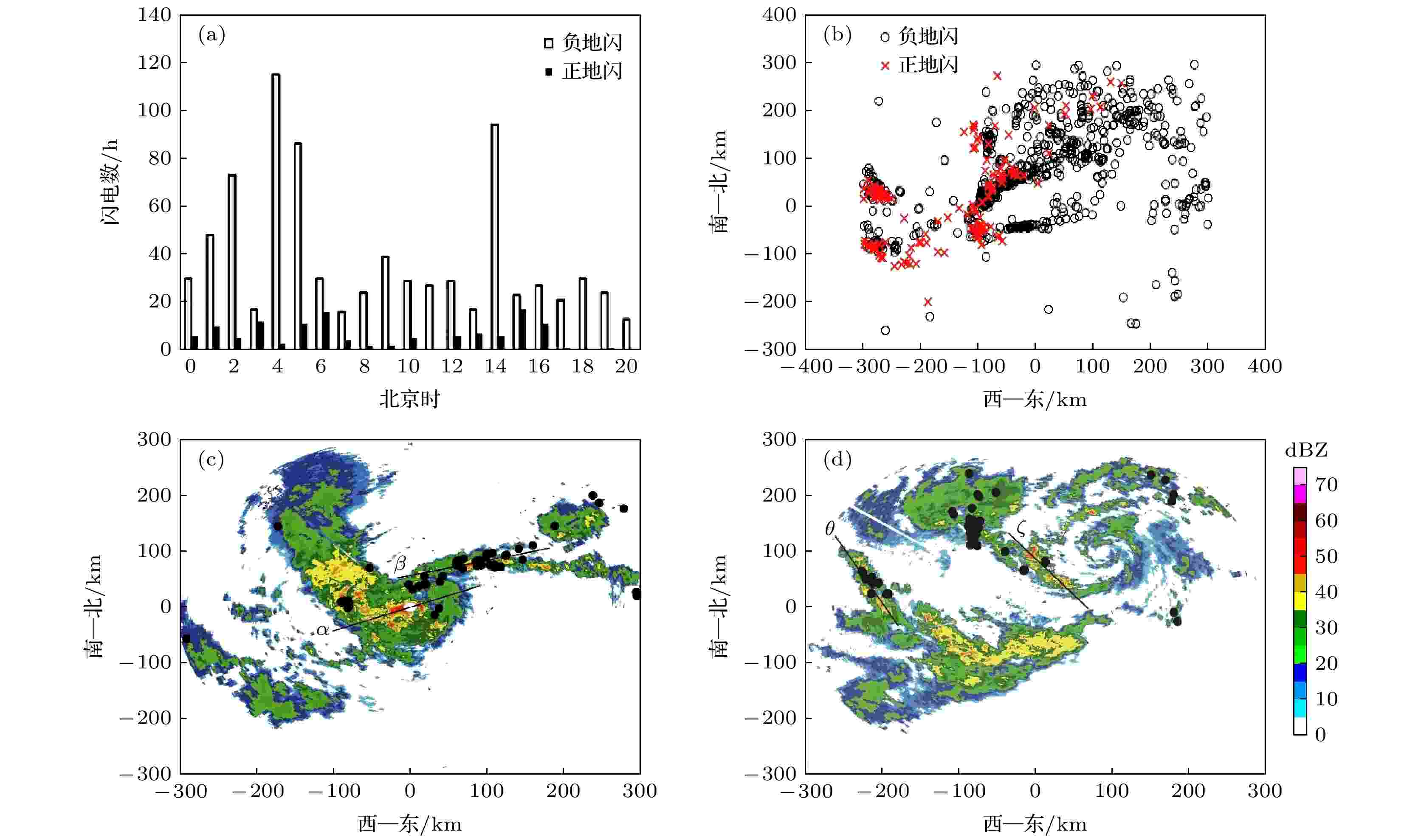 图 3 2019年8月1日0:00 ~ 20:00时段1907号台风登陆海南与登陆湛江前后的地闪特征 (a)地闪活动的时间演变; (b)地闪活动的空间分布; (c)和(d)分别为04:27和14:32前后15 min内地闪与雷达回波的叠加, 黑色圆点代表地闪. 图中直线α, β, ζ和θ为图4对应的剖面位置
图 3 2019年8月1日0:00 ~ 20:00时段1907号台风登陆海南与登陆湛江前后的地闪特征 (a)地闪活动的时间演变; (b)地闪活动的空间分布; (c)和(d)分别为04:27和14:32前后15 min内地闪与雷达回波的叠加, 黑色圆点代表地闪. 图中直线α, β, ζ和θ为图4对应的剖面位置Figure3. The characteristics of cloud-to-ground flashes in typhoon No.1907 before and after landing in Hainan and Zhanjiang from 0:00 to 20:00 on August 1, 2019: (a) The evolution of cloud-to-ground flash activities; (b) spatial distribution of cloud-to-ground flash activities; (c) and (d) are the superposition of the flash locations upon radar echo for 30 minutes around 04:27 and 14:32, respectively, and the black dot represents the cloud-to-ground flashes. The line α, β, ζ and θ in this figure is the location of corresponding section in Fig. 4.
研究指出[16], 台风眼壁区的对流结构类似于海洋季风深对流, 雷达回波特征表现为最强回波位于0 ℃层以下, 0 ℃层以上回波迅速减小, 这种特征表明眼壁内过冷水和强大上升气流的缺乏, 一定程度上限制了冰晶和霰粒子的碰撞起电, 使得眼壁内的闪电活动相对螺旋雨带较弱. 为了分析地闪活动与回波强度之间的关系, 这里对两次地闪峰值阶段(8月1日4:00和14:00)对应的雷达回波剖面进行了分析, 如图4所示. 在地闪频数首次达到峰值的时段, 尽管眼壁内的回波强度较大, 达到了45—50 dBZ, 但高度局限于海拔6 km以下且往上回波快速减小, 另外, 云顶高度也在14 km以下, 如图4(a)所示; 对于同时段闪电较为活跃的内雨带, 35— 40 dBZ的回波顶高达到了约10 km且云顶高度也接近18 km(图4(b)), 这表明强回波区的高度和深对流发展对闪电的发生有着显著的影响. 然而, 在第二个地闪峰值期间, 内雨带回波较强且云顶高度较高的区域(图4(c))发生的地闪数目反而小于回波弱且高度较低的区域(图4(d)), 这可能与云内电荷区的配置有一定的关系. 由图4可见, 内雨带的回波剖面最接近于常规雷暴云的回波结构, 这可能就是内雨带闪电容易发生的原因, 而外雨带的回波则更接近于层云降水区的特征.
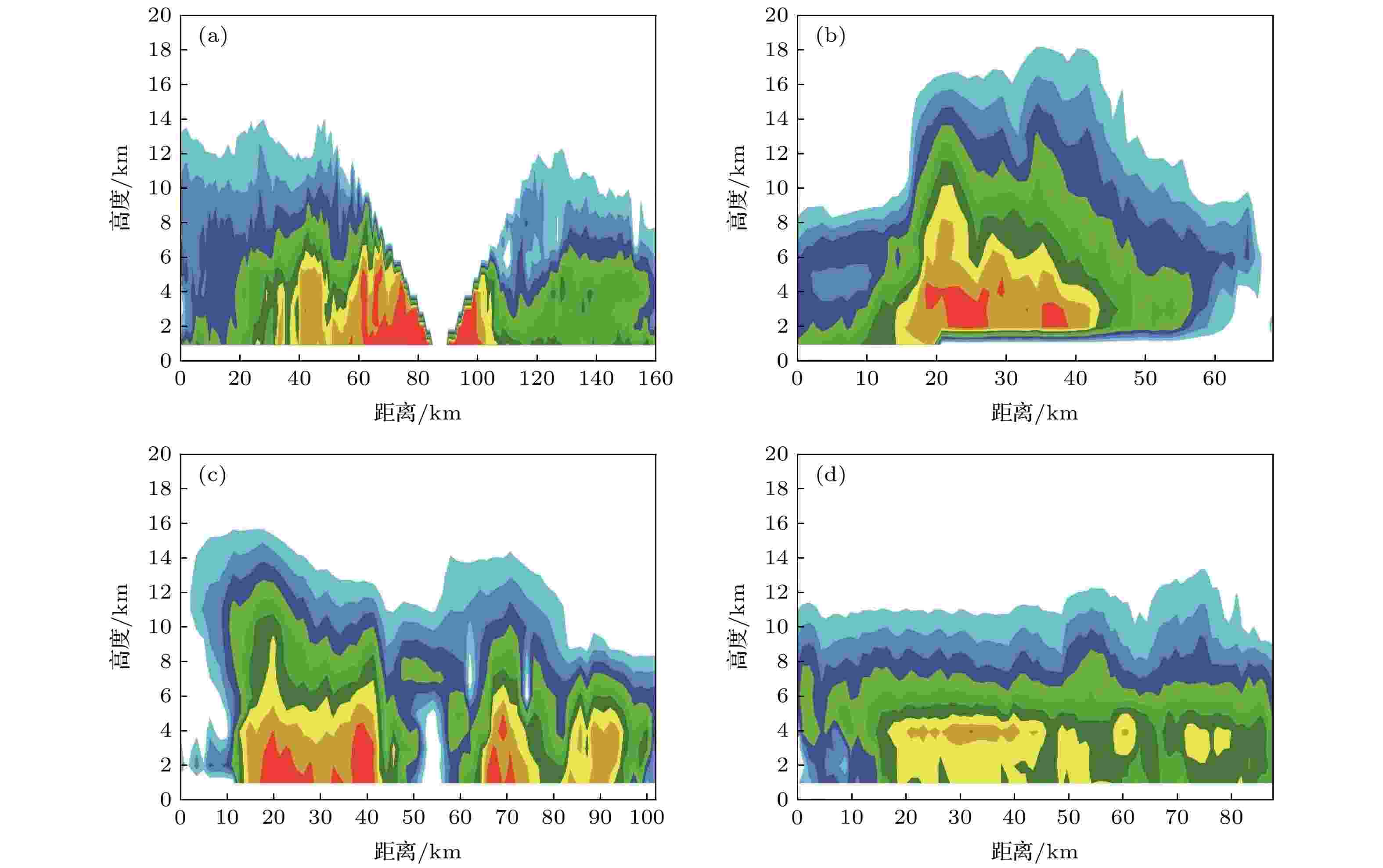 图 4 图3(c)和图3(d)中沿直线α, β, ζ和θ的雷达回波垂直剖面(回波强度同图3色标) (a)沿直线α; (b)沿直线β; (c) 沿直线ζ; (d) 沿直线θ
图 4 图3(c)和图3(d)中沿直线α, β, ζ和θ的雷达回波垂直剖面(回波强度同图3色标) (a)沿直线α; (b)沿直线β; (c) 沿直线ζ; (d) 沿直线θFigure4. Radar echo vertical cross section of line α, β, ζ and θ in Fig.3(c) and Fig. 3(d) (The colorbar is the same as Fig. 3): (a) Line α; (b) line β; (c) line ζ; (d) line θ.
2
3.3.垂直电场廓线特征
本次探空气球穿云的时段为2019年8月1日9:53:11—10:25:12, 整个探空过程时长约32 min, 10:23:04, 探空到达云顶上边界10—15 dBZ的区域, 电晕电流也归为零值. 由葵花卫星红外云图、海口雷达回波以及探空路径判断, 此次探空进入了台风的眼壁. 图5(a)分别给出了探空时段内(10:09)3 km高度处的雷达回波, 可见, 探空点位置(黑色三角形)处于台风眼的附近区域. 图5(b)为图5(a)中黑色方框区域的放大, 黑色线条为探空路径的地面投影与回波的叠加, 自探空点位置气球朝东偏北飞行了约27 km. 为了确定探空路径在雷达垂直剖面上的投影位置, 以接近路径的直线AB对回波进行剖面处理, 由图5(c)可知, 这次探空自释放后倾斜上升, 进入云体后, 在高度约3 km处进入了强回波中心, 在海拔10 km高度处穿过了云顶, 除了2 km以下的路径处于云的边缘外, 在此以上都处于云体内部. Zhang等[38]通过计算指出, 假设云内电荷区分布在水平上是均匀的, 只要探空路径不完全处于云的边缘, 那么电场探空结果可以较好地反映云内的电荷分布特征.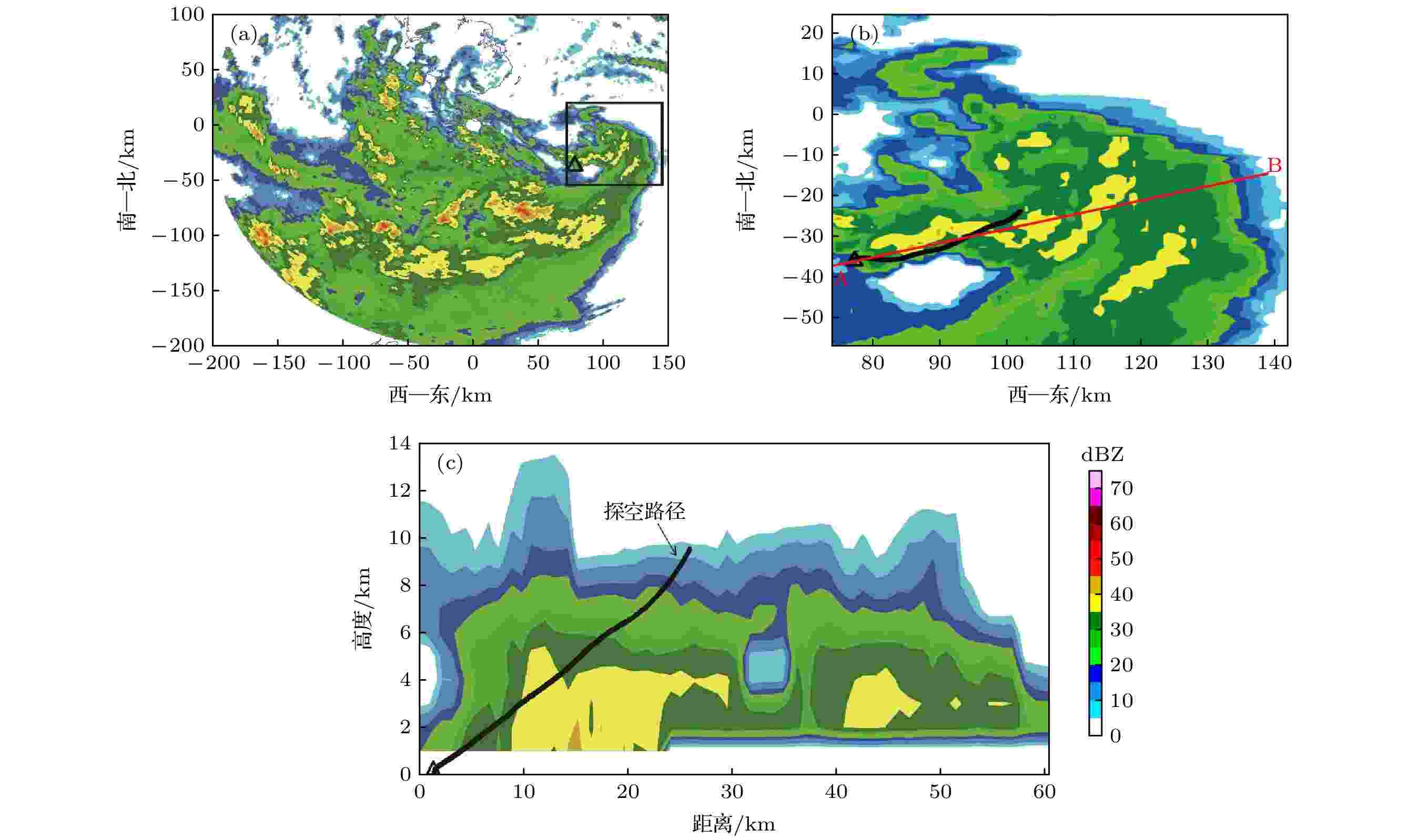 图 5 探空时段内的雷达回波的反射率以及垂直探空路径在回波剖面上的显示 (a) 10:09时的反射率(3 km高度处); (b)图(a)中黑色方框区域的放大, 显示探空路径与回波的地面投影以及剖面切割线(线段AB); (c)探空路径在回波剖面上的投影, 图中△代表气球释放点位置
图 5 探空时段内的雷达回波的反射率以及垂直探空路径在回波剖面上的显示 (a) 10:09时的反射率(3 km高度处); (b)图(a)中黑色方框区域的放大, 显示探空路径与回波的地面投影以及剖面切割线(线段AB); (c)探空路径在回波剖面上的投影, 图中△代表气球释放点位置Figure5. Sounding path and the corresponding Radar echo (10:09): (a) Radar echo at height of 3 km; (b) enlarged view of the section in the square of picture (a), the line AB is the location of vertical cross section and the black curve is the horizontal projection of the sounding path; (c) superposition image of radar echo vertical cross section of line AB in the (a) and sounding path. △: Sounding site.
图6给出了此次电场探空得到的气球上升速度、电晕电流、垂直电场及电荷区分布. 由于台风“韦帕”整体偏弱, 眼壁区最强回波只有35—45 dBZ, 气球上升速度基本维持在4—6 m/s之间. 由电晕电流反演得到的电场图6(c)来看, 最强负极性电场值为35.5 kV/m, 位于6.21 km (–3.60 ℃)高度处; 对于正极性电场, 最大值达到饱和, 其值为62.9 kV/m, 高度处于7.53—7.89 km (–9.15—–11.21 ℃)之间, 根据饱和电场上下相邻区域电场廓线的线性演变趋势, 通过斜率大致可以推断最大正极性电场有可能达到79.86 kV/m(–10.37 ℃). 上部负极性电场峰值为–19.77 kV/m(–18.63 ℃), 其高度为8.87 km. Marshall和Rust[39]对墨西哥山地雷暴上升气流区内和上升气流区中心附近的垂直电场廓线的分析发现, 垂直电场的绝对值廓线有三个峰值组成且最大的是负电场峰值, 下部正电场峰值在海拔5.8 km处, 中部负电场峰值在7.3 km 处, 上部正电场峰值出现在10.3 km 处(电场极性定义与本文相反). 对比可知, 除了上部负电场峰值的海拔相对雷暴的较低外, 其余两个电场峰值对应的高度基本相当. 一般上升气流区内外的电结构存在差异[40], Stolzenburg 等[41]通过探空发现, 上升气流区外围的垂直电场廓线一般有四五个峰值.
 图 6 2019年8月1日9:53:11—10:23:04台风眼壁区内的探空结果 (a)上升速度; (b)电晕电流; (c)电场(E)、温度(T); (d)电荷密度
图 6 2019年8月1日9:53:11—10:23:04台风眼壁区内的探空结果 (a)上升速度; (b)电晕电流; (c)电场(E)、温度(T); (d)电荷密度Figure6. Sounding results in eyewall of No.1907 typhoon on August 1, 2019 (9:53:11–10:23:04): (a) Ascending velocity; (b) corona current; (c) E-field (E) and temperature (T); (d) charge density.
由探空可知, 在台风眼壁9.1 km以上区域的电场为零值, 而云上边界在10 km处, 这表明9.1—10 km范围内的水成物粒子为电中性的或荷电量较小未被探测到. 另外, 海拔5.74 km以下, 电场也保持为零值, 而0 ℃的高度为5.32 km, 也就是说, 台风眼壁区内电荷区均位于0 ℃以上的冰相混合区, 这符合对流云非感应起电机制作用的区域[42,43], 而在温度暖于0 ℃的区域基本不直接参与起电.
2
3.4.云内电荷区垂直分布特征
假设眼壁内的电荷分布是近似水平均匀的, 那么就可以利用一维高斯公式(2)式计算垂直方向上云内的电荷区分布特征. 由图5(d)可知, 在高度5.74—9.10 km之间(对应的温度为–2.4—–16.7 ℃)共有不同强度和极性的电荷区共有7个, 其中包括3个负电荷区和4个正电荷区, 如图中N1, N2, N3, P1, P2, P3和P4所示(P和N分别代表正和负). 自下往上7个电荷区的平均电荷密度分别为0.63, –0.33, 0.31, –1.03, 1.70, 1.57和–1.20 nC/m3, 各电荷区中心高度依次位于6.02, 6.38, 6.58, 7.11, 8.06, 8.81和8.95 km. 可见, 下部的3个电荷区对应的电荷密度都小于1.0 nC/m3, 而上部的四个电荷区的电荷密度都超过了1.0 nC/m3. 电荷区的强度(电荷区所含的电荷量)除了受电荷密度大小影响外, 直接与电荷区的体积相关, 为了评价各个电荷区相对强度大小, 通过计算电荷密度与体积的乘积就可得到, 但由于无法获知云内电荷区的水平尺寸, 因此, 通常采用电荷密度(ρ)与电荷区厚度(?z)的乘积对比各个电荷区的相对强弱. 电荷区自下往上的厚度分别是0.52, 0.20, 0.20, 0.85, 0.33, 0.11和0.15 km, 通过计算得到各电荷区的相对强度依次为0.33, –0.07, 0.06, –0.87, 0.55, 0.18和–0.18 nC/m2. 由此可见, P1, N2和P3是此次探空期间眼壁区内强度最大的三个电荷区, N3和P4次之, 而N1和P2是强度最小的两个电荷区.由以上分析可知, 探空仪穿过的眼壁区在垂直方向上共有7个电荷区存在, 整体分布较为复杂, 这与Stolzenburg等[41]雷暴云的电场探空观测结果有一定的相似性. 若只考虑眼壁内强度较大的3个优势电荷区P1, N2和P3, 这3个优势电荷区自下往上呈正、负、正的三极性结构排列, 这种分布与雷暴云的三极性电荷结构分布是否具有一致性还有待进一步的分析. 雷暴云内的电荷区在垂直方向上基本都呈极性交错的方式排列, 而P3和P4作为相邻的两个电荷区极性一致, 因此, 本文推测这两个电荷区应该属于同一个电荷区, 只是由于二者之间区域的电荷密度较小, 使得电场达不到探针放电的电场阈值, 从而在实况资料上显示为两个独立的电荷区. 若二者确属同一电荷区, 那么上部主正电荷区(P3与P4合并)的平均电荷密度为0.75 nC/m3, 但由于电荷区厚度的扩展为0.97 km, 电荷区的强度调整为0.73 nC/m2. 在云顶的附近区域有一个负电荷区, 这应该是雷暴云顶部经常被观测到屏蔽电荷层[44]. 因此, 1907号台风探空区域内的电荷结构整体呈四极性电荷结构, 最下部为正电荷区, 往上依次改变极性, 最上部为负极性屏蔽电荷层.
2
3.5.地面电场的演变特征
在探空点的大气平均电场仪完整地记录了台风登陆前后的地面电场, 这里定义地面正极性电场对应云内正电荷控制地面电场. 图7给出了1907号台风前两次登陆前后的地面电场, 可见, 在登陆前后00:00—03:25期间的电场有明显的波段变化, 此后在03:26—08:55的地面电场基本接近于0 kV/m, 该时段对应电场仪处在台风眼边缘的下部; 在08:56—09:53期间出现负极性电场并且伴随有闪电引起的快速变化, 最大电场强度在5—8 kV/m之间, 而站点上空覆盖有台风眼壁的弱回波云; 探空期间的地面电场虽然主要呈正极性, 但没有显著的变化且电场值很弱; 在10:25—11:06期间电场又基本归于零值附近, 随后随着台风的向北移动, 电场再次出现较大幅度的波动, 极性主要为负极性, 对应台风的回波强度已有所减弱, 地面电场也于台风登陆湛江前1个小时归于零值. 从地面电场演变并不能得到更多与电荷结构有关的信息, 但可以确定的是随着眼壁区位置的不同, 云内电荷分布还是存在着不同程度的差异, 否则根据电场探空给出的电荷分布来看, 地面电场理应由云内下部正电荷区控制, 而实际情况并非如此, 除了地面电场出现较大的波动外, 有些研究表明眼壁区内的闪电分布存在区域上的差异, 如Fierro等[22]发现眼壁双极性窄脉冲事件的爆发随时间呈逆时针方向依次发生, 揭示了眼壁强对流单体的时空演变在不断地对电荷区进行调整.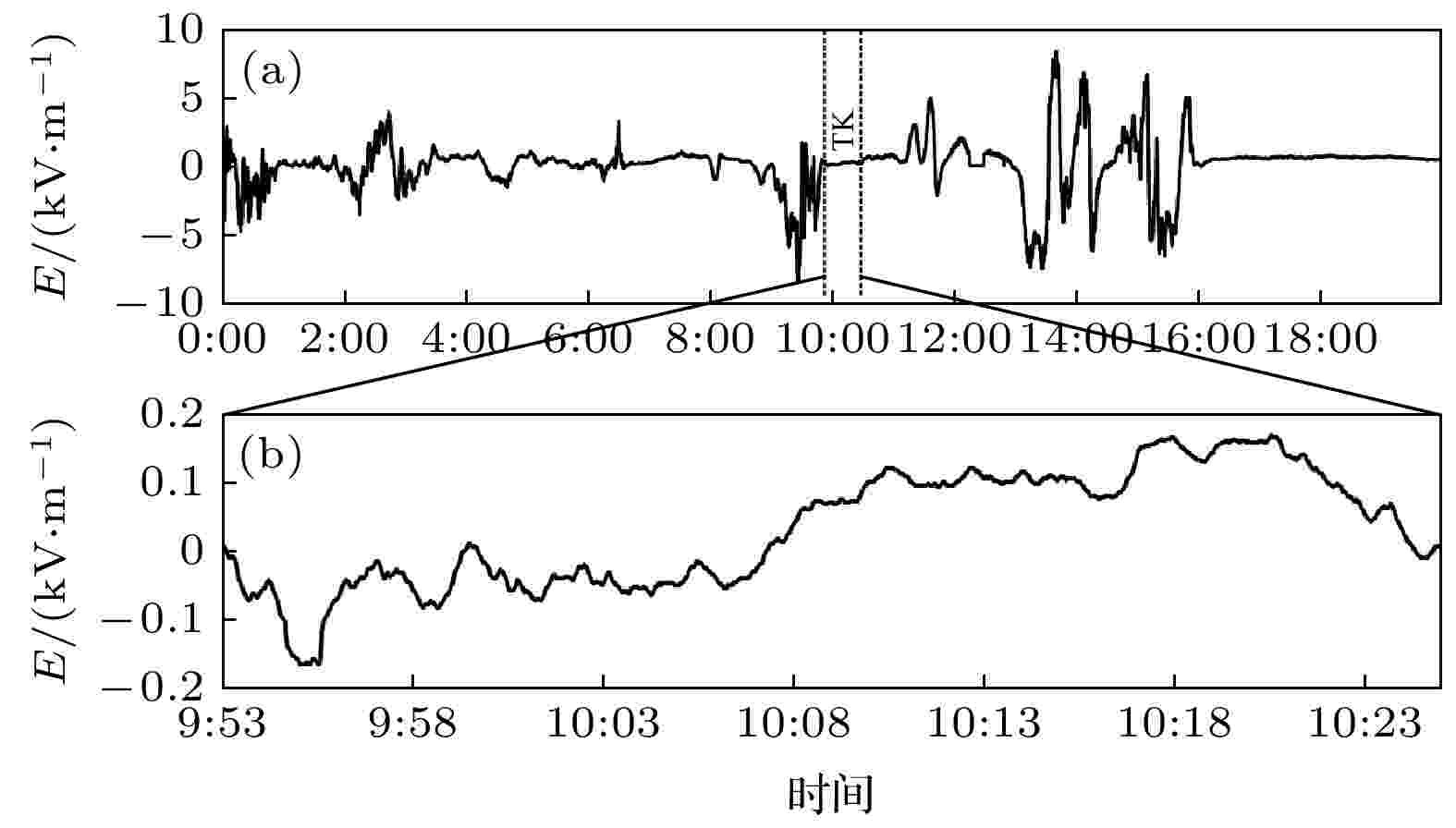 图 7 台风地面电场监测 (a) 8月1日0:00—20:00, “TK”代表探空时段; (b)探空时段地面电场的扩展
图 7 台风地面电场监测 (a) 8月1日0:00—20:00, “TK”代表探空时段; (b)探空时段地面电场的扩展Figure7. Evolution of surface electric field of No.1907 typhoon: (a) The time period from 0:00 to 20:00 on 1st August, “TK” stands for the sounding period; (b) enlarged view of sounding period as “TK” in Fig. (a).
1)虽然1907号台风达到热带风暴级别长达17个小时, 但整体地闪活动较少, 空间上并没有显著的分布特征, 但眼壁内的地闪要明显小于内雨带的; 从时间的演变来看, 地闪峰值在登陆海南文昌后2小时达到峰值, 而第二峰值在登陆湛江前3小时出现.
2)从电场廓线计算得到的电荷区来看, 云内共探测到7个电荷区, 若最上部的两个正电荷区是同属一个电荷区, 那么最小部的电荷区为正极性, 往上依次改变极性, 它们的电荷密度(中心高度)分别为0.63 nC/m3(6.02 km), –0.33 nC/m3(6.38 km), 0.31 nC/m3 (6.58 km), –1.03 nC/m3(7.11 km), 0.75 nC/m3 (8.38 km)和–1.20 nC/m3(8.95 km). 可见, 最上部的3个电荷区电荷密度是最大的, 但考虑各电荷区的厚度, 它们的强度分别为0.33, –0.07, 0.06, –0.87, 0.73和–0.18 nC/m2, 强度最大3个电荷区为最下部的正电荷区与其上部的主负和主正电荷区.
3)此次探空给出的结果显示, 眼壁内探空路径区域内的优势电荷区在垂直方向上呈三极性电荷结构, 在云上部还存在一个负极性的屏蔽电荷层. 雷暴云经典的三极性电荷结构特征基本为: 云下部是正电荷区, 位于暖于0 ℃的区域; 中间是主负电荷区, 位于0 — –10 ℃的区域; 上面是一个主正电荷区, 对应温度低于–10 ℃的区域[45,46]. P1, N2和P3电荷区对应的温度分别处于 –3.1 — –5.7 ℃, –7.7 — –11.9 ℃ 和 –13.7 — –15.3 ℃. 首先, 此次观测得到的下部正电荷区对应的温度冷于0 ℃, 这有别于雷暴三极性电荷结构下部正电荷区所在的温度层. 在雷暴下沉气流区, 下部正电荷区一般出现于0 ℃层的下部[41]; 另外, 当雷暴处于消散阶段时, 处于混合相下部的正电荷区下沉到暖于0 ℃的区域[47,48]. 至于1907号台风在成熟阶段下部正电荷区是否也存在这种特征无法确定. 对于中部主负电荷区, 很多雷暴云内的电场探空发现主负电荷区所对应的温度层为–15 — –5 ℃, 厚度为千米量级[49,50], 这与此次探空对应的负电荷区(N2)的位置基本符合这一条件. 台风眼壁上部主正电荷区位置也与雷暴云三极性电荷结构的符合. 对于云顶部的负极性屏蔽电荷层, 其存在的区域位于10—15 dBZ之间, 这与Dye 和Willett [51]的飞机观测结果和Stolzenburg等[44]的电场探空结果基本一致.
4)目前有关雷暴云内的起电机制主要考虑霰粒-冰晶的碰撞起电的非感应起电机制和极化粒子碰撞分离产生电荷转移的感应起电. 霰粒-冰晶起电机制由于较高的起电效率且能很好地解释三极性电荷结构而被广泛认同[28,52], 而感应起电机制需要有强度大于10 kV/m的外电场条件[53]. 在台风起电的数值模拟中也主要考虑这两种起电机制, 徐良韬等[54]发展了WRF起电模式, 该模式采用了修正后的非感应起电方案[55]和感应起电方案[56]. 利用该模式, Xu等[34]通过对台风的模拟发现, 热带气旋眼壁区的对流一般具有中负下正的电荷结构, 分析认为是大小冰相粒子间碰撞位置的温度偏高, 使得产生较大的霰粒子荷正电和较小的冰晶粒子荷负电; 另外, 该研究发现热带气旋加强阶段的眼壁内深对流呈三极性电荷结构. 在对台风莫拉菲的模拟中, 徐良韬等[57]发现眼壁在近海加强阶段呈现正的三极性电荷结构, 而在台风达到最大强度后呈现负的偶极性电荷结构, 而外雨带对流电荷结构主要呈现正偶极性或三极性电荷结构, 不受台风强度变化及登陆过程影响. 这些研究表明, 台风过程与雷暴的电荷结构具有一定的相似性, 但考虑到动力差异, 二者在起电机制方面是否有所不同还需要更多的观测和研究进行证实.
本研究工作得到了西昌卫星发射中心气象台和西昌卫星发射中心气象台气象水文室在观测场地保障和地面电场资料方面提供的支持, 特别感谢张春峰同志在探空作业中的大力协助.
